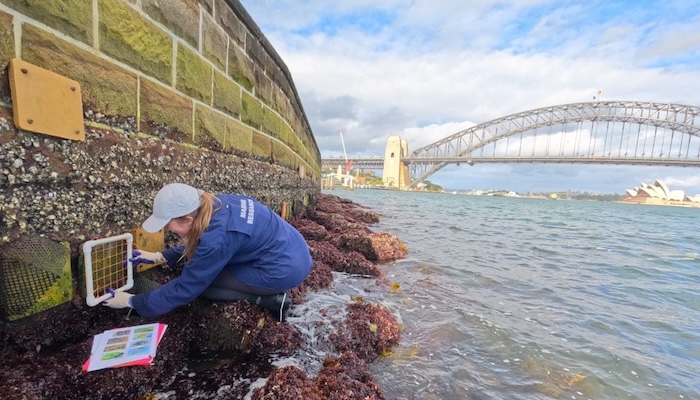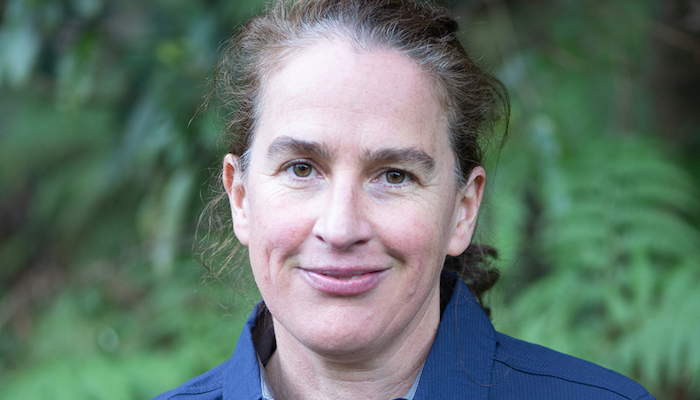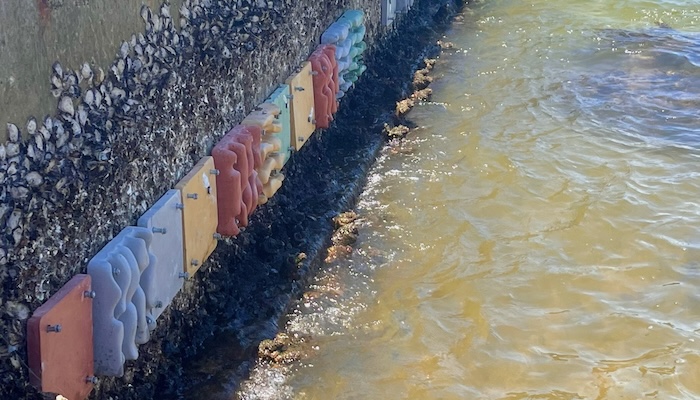A new study published in the Journal of Applied Ecology by researchers from Macquarie University and the Sydney Institute of Marine Science has found the colour of concrete can significantly affect which marine organisms make their homes in urban seawalls.

Waterfront makeover: Scientists attach coloured panels to seawalls around Sydney Harbour in a bid to boost marine life. Image: Holly Cunningham
Their findings suggest a simple, low-cost design tweak – adding colour – could help revive marine life along concrete-dominated coastlines.
As cities expand into the sea, natural shorelines are increasingly replaced by concrete seawalls, pilings and pontoons. These built structures now dominate, replacing not only habitat structure, but also the rich palette of colours found in nature.
Most marine infrastructure is made from plain grey concrete which is strong, cheap, and durable, but visually uniform and biologically unfamiliar. Natural shorelines, by contrast, feature a rich palette of colours. These colours don't just look good, they can influence how marine species interact with their environment, the scientists discovered.
"Many marine animals respond to light and colour when choosing a place to settle," says senior author Dr Laura Ryan, from Macquarie University's School of Natural Sciences.
"So we asked: if we make concrete more colourful, can we improve marine biodiversity?"
Testing the rainbow theory
To test this, the team created coloured concrete panels — red, yellow, green, and standard grey — and attached them to seawalls around Sydney Harbour. Over 12 months they tracked which organisms settled on each panel and whether fish eating them influenced the outcome.
Adding colour: Red, green, grey and yellow panels deployed on Sydney Harbour seawalls. Image: Dr Laura Ryan
They found marine invertebrates and seaweeds colonised panels differently depending on the panel colour. Red panels in particular supported communities distinct from other coloured panels, attracting higher numbers of green algae and barnacles.
These differences held even when fish grazed freely on the panels, suggesting that colour effects were not driven by helping creatures blend in, but were influencing where larvae settle.
"We were surprised that even after the panels were fully covered in marine growth, the original colour continued to influence which species were present," says Holly Cunningham, first author on the study.
"It shows that surface colour continues to matter long after the surface is no longer visible."
The colour effects also varied according to the panel's location on the seawall, with colour showing much stronger effects in the lower parts of seawalls that were underwater for longer periods.
Using the Light
The researchers also discovered that the effects weren't just about what organisms could see, they may relate to how different species use light.
"Red panels may represent high-quality habitat for green algae, which capture light for photosynthesis in the blue and red spectrum," the study notes.
Incorporating colour into marine design is practical, affordable, and easy to scale, potentially bringing back a forgotten sensory cue that many species rely on.
Meanwhile, brown algae, which absorb light differently, showed greater associations with grey and green surfaces than with red ones.
Perhaps most surprisingly, the study found these colour preferences persisted throughout the entire 12-month experiment, with the original colour continuing to influence which species thrived even when the concrete was no longer visible underneath layers of growth.
Until now, projects such as Living Seawalls aimed at restoring habitat to marine infrastructure have focused on adding texture, such as grooves and crevices, to mimic natural habitats.
This study suggests that adding colour using long-lasting pigments like iron oxides, may also make a meaningful difference to seawalls.
As coastal cities grow, it's becoming even more important to understand how changes in the colourscape affect marine life, says coastal ecologist Professor Melanie Bishop from Macquarie University, supervising author and co-leader of the Living Seawalls project.

Expertise: Professor Melanie Bishop, pictured, is a co-leader of the Living Seawalls project and supervised the new coloured panel marine research.
"We are trialling more of these coloured panels in the water now," says Professor Bishop.
"Incorporating colour into marine design is practical, affordable, and easy to scale, potentially bringing back a forgotten sensory cue that many species rely on, so if we keep finding that colour matters, the eventual outcome would be to incorporate colour into Living Seawalls in a way that mimics native environments."
Professor Bishop says traditional grey infrastructure could inadvertently create environments hostile to many native species, by eliminating the visual cues these organisms have evolved to recognise and respond to over millions of years.
Co-designing infrastructure with nature in mind not only supports marine biodiversity, but also sustains vital marine ecosystems impacting clean water, fisheries and carbon storage.
"This study suggests engineers and planners should consider matching the brightness and colours of artificial structures to the dominant colours found in local natural habitats, so they can give native marine life the visual cues they're naturally programmed to seek out."
Dr Laura Ryan is a Research Fellow in Comparative Neurobiology at Macquarie University's School of Natural Sciences.
Professor Melanie Bishop is a coastal ecologist in the School of Natural Sciences at Maccquarie University and co-leader of the Living Seawalls Project.







